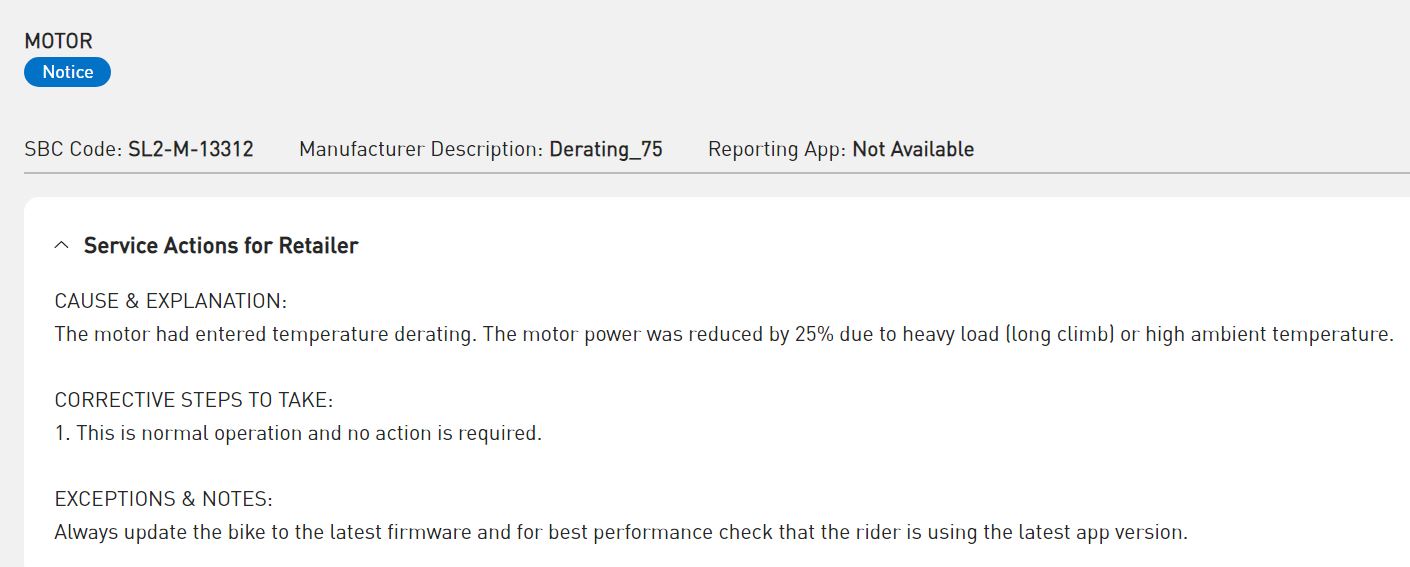All Turbo Bikes
CHARGING
| COMPONENT/EVENT | BEHAVIOUR / ROOT CAUSE | USER ACTION / CONTEXT |
| Battery cell temperature: Charging is prevented if cell temperature is out of range. | To protect the system and to make charging safe, charging will be prevented under certain circumstances, for instance if cell temperature is below 0 °C / 32 °F or above 50 °C / 122 °F. LED will blink red in case charging is not possible for safety reasons. | • Make Riders aware • Refer to manual and battery symbols |
DIS-CHARGING (RIDING)
| COMPONENT/EVENT | BEHAVIOUR / ROOT CAUSE | USER ACTION / CONTEXT |
| Battery cell temperature: Power reduction at low cell temperatures | The system can only deliver full output when the battery cell temperature is within a certain range, usually 0°-50°C. Temperatures outside this spectrum result in a reduction of motor support. In extreme scenarios, the system reduces power output or motor support stops completely. | • Avoid exposing the bike/battery to extreme temperatures over a longer period of time. • Store your Turbo bike or battery at room temperature before riding in cold conditions (especially when below 0° C / 32° F) |
| Motor: Power reduction at high motor temperatures (thermal derating) | All Turbo systems are built to provide best efficiency and best-in-class heat management. However, there are temperature conditions for the motor in which the system protection mechanism would initiate a reduction of motor power to prevent further heat build-up. This is called «derating» and can manifest in multiple reduction stages. In extreme cases, the protection mechanism can trigger a motor shut-off to prevent damage to motor internals. Heat build-up primarily depends on: • Terrain conditions (gradient, surface) • Motor support level (higher support = more heat) • System weight (rider + bike) • Ride time with high loads • Ride style (cadence) • Ambient temperature Instances of temperature-related motor power reduction are recorded and can be seen in the Turbo Studio Event Log (bikes with TCD-w display and later). See example image.  | The rider cannot damage anything because the system is self-protecting, but can act in a way to avoid unnecessary heat build-up by: • Pedalling in a higher cadence spectrum (75rpm +) • Not leaving the bike in the sun when not riding • Avoiding unnecessary weight/resistance • Allowing for some cool-down time if motor support temporarily got disabled |
| Battery: Power reduction at lower soc levels | In normal temperatures (0 – 50°C), the battery will start limiting power output at 15-20 % rsoc, depending on the system. This happens to protect the system from over discharge and to allow stable motor support till shut-off. | • Keep in mind • (r)soc = (remaining) state of charge |
| Battery: Motor support stops at soc levels from 1% – 5% | Generally, the point of 0% motor power depends on multiple variables. Usually, motor power is 0% when hitting 1-3% rsoc, but can shut off at higher levels. The reason is that 1% rsoc is sufficient to power bike lights for another 2 hours and get the rider home safely. In colder temperatures, the power is limited from the start and motor support is cut at higher rsoc levels. | • Keep in mind • (r)soc = (remaining) state of charge |
BATTERY STATE OF CHARGE
| COMPONENT/EVENT | BEHAVIOUR / ROOT CAUSE | USER ACTION / CONTEXT |
| TCD/TCD-w, MC or other displays show less soc % after 2+ hours of inactivity | When turning on the bike after more than two hours since last use, the soc displayed on the TCD and/or in MC can differ from the one displayed before turning off the bike. The difference can be up to 6%. | • Keep in mind • (r)soc = (remaining) state of charge |